
It’s an emergency. The Labor Party says so. Shadow spokesman for Environment, Climate Change and Water, Mark Butler is urging the Morrison government to declare a climate emergency.
Apparently, the immediate declaration of a climate emergency is Labor policy now although it’s hard to tell. It is this week anyway. Since Tuesday.
These are difficult times for politicians and messaging. An internet-driven ADHD afflicts the nation. Social media dictates any video longer than a minute and a half and eyes will glaze over.
READ MORE: Why Extinction Rebellion want to declare a climate emergency
I watched Butler’s declaration and stoically stayed viewing to see him earnestly quoting Barack Obama about the need to declare an emergency. The seconds ticked down. Surely there would have to be some detail. An emergency requires an emergency response, doesn’t it? All hands to the pump, keep both eyes on the wheel, what?
Today, Labor declared a climate change emergency because future generations deserve nothing less. pic.twitter.com/MimUe5Q6J8
— Mark Butler MP (@Mark_Butler_MP) October 15, 2019
It wasn’t even Labor’s idea. The declaration of a climate emergency is something Extinction Rebellion have been supergluing their faces to road surfaces over for weeks. The Greens have been pushing for it for years.
In the third and most despised tier of government in Australia, local government, some municipalities have already got to their feet to make the declaration.
The first of these was the City of Darebin, an inner northern suburbs council in Melbourne who declared a climate emergency two years ago.
I took the time to examine the announcement and what it means. Any guesses? Sorry but there is no prize for the neatest, most correct response because the answer is entirely predictable. It is not quite nothing but so close to it that it is almost impossible to tell the difference.
The sages of Darebin City Council came up with a four-step plan in a proclamation I have abbreviated in the interests of common sense and so your eyes don’t glaze over and you feel inclined to turn to another column or a cartoon or something. Here ‘tis:
(1) Adopts the Darebin Climate Emergency Plan (the Plan) attached as Appendix B to this report…
(2) Calls upon the State and Federal Governments to declare a climate emergency and for both governments to back this up with legislated programs to drive the emergency speed creation of a safe climate economy.
(3) Signs up to the Global Covenant of Mayors for Climate and Energy.
(4) Signs up to TAKE2 Victoria’s collective climate change pledge.
It was symbolism so hollow that an entire family of tawny frogmouth owls could live in it. It was not just a victory for style over substance, it was substance rocking back and forth in the foetal position while Genghis Khan’s Mongol hordes are smashing the citadel door down.
Reading further from ‘The Plan’ it became clear the only practical measures listed required Darebin City Council to spend $20 million on solar energy projects. That’s it. The rest of Darebin’s Climate Emergency Plan is a long rota of heart-warming memoranda accompanied by some finger wagging at other governments, perfect bound with a glossy cover.
Since Darebin kicked off the emergency, cities and entire countries have declared climate emergencies. The United Kingdom, Canada, France, Argentina, Spain and Austria have taken a leaf out Darebin City Council’s book. Even the Vatican has jumped on board. Who knows, when we have the next papal election, the white smoke from the conclave might have to be delivered instead by semaphore.
Many of these countries already have policies in place to reduce their emissions. They may be guilty of turning to symbolism, but policy substance exists for good or ill. Here in Australia, we couldn’t possibly say the same thing. Emissions are rising. The mechanisms, relying on publicly funded models rather than polluter pays models, have seen emissions rising. Regardless of your outlook, if you establish expensive policy to do one thing and it does the opposite, it is time to look at another model.
In the Labor Party, there is an ongoing barney over the stated policy of reducing carbon emissions by 45 per cent in 2015 terms by 2030 and net zero emissions by 2050, the latter part being in line with the Paris commitment. But the former target is said to be under review and is the subject of much to-ing and fro-ing and gnashing of teeth within the party, despite Butler’s statement in the aftermath of the election defeat where he said Labor’s climate policies are “unshakeable”.
They are being shaken now and almost certainly will change prior to the next election.
The Labor Party is left to do a poor impersonation of the Darebin City Council. Opting for feelgood statements rather than objective evidence-based policy. When given a choice between doing the hard policy yards and vapid symbolism, the Labor Party invariably turns to the latter. In the case of Butler’s declaration, it is the Australian political equivalent of yelling ‘Fire!’ in a crowded theatre.
That’s where we are in this nation, at least where energy and climate policy sit. It’s a choice between a government with a bad idea to an alternative government that has no idea.




Cue sirens and flashing lights. Run for the hills! Dash about in a mad panic. Where’s the dog? Where did you leave your keys? Forget about gathering up keepsakes. There’s no time for that frippery now. Run!